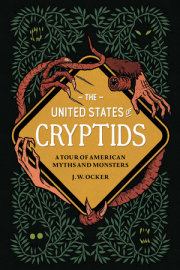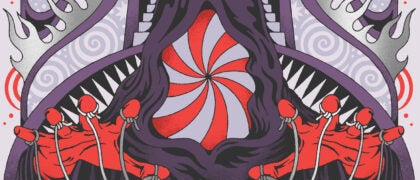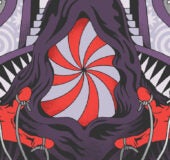Cult is a scary word. Like
terrorist. Or
leprosy.
Sharknado. Even people in cults don’t like the word
cult. Dictionary definitions do little to encapsulate the fear and loathing the word inspires. Merriam-Webster simply describes a cult as “a religion regarded as unorthodox or spurious.” The Oxford English Dictionary gets us a little closer to the creepy connotation with “a relatively small group of people having (esp. religious) beliefs or practices regarded by others as strange or sinister, or as exercising excessive control over members.”
Noted psychiatrist Robert Jay Lifton, in the 1991 paper “Cult Formation,” goes deeper. To paraphrase, the three elements of his definition are:
1. A charismatic leader who often becomes an object of worship
2. A process of indoctrination
3. A mechanism of exploitation, whether that be financial, sexual, or otherwise
Now things are getting scary. But it gets even worse.
Cults often seem to end badly—whether in mass suicide, mass murder, or mere public embarrassment. Such as Heaven’s Gate members dead in their bunks, stomachs full of phenobarbital and applesauce. Or Chen Tao in their white clothes and cowboy hats despondently leaving their suburban Texas neighborhood when UFOs didn’t arrive on the day their leader promised. Or
Game of Thrones fans turning off their TVs, gobsmacked at how eight years of investment and dedication were rewarded with anticlimax. And there’s always the good rule of thumb that if a group’s leader wound up dead or in jail, the group was probably a cult.
Despite these multiple definitions, and despite the stranglehold cults have on the public imagination, it’s surprisingly difficult to define a cult, or even to recognize one. For example, there’s a thin, blurry line between a religion and a cult. Lifton’s definition can easily apply to any religion—but the imperceptible delineation between a cult and a religion might just be its level of success. Religions are big. Mainstream. And as for ending badly, religions are large and influential enough to absorb or withstand crimes, scandals, and tragedies within their structures and continue on, ties straightened, collars starched, and halos burnished, in a way that smaller sects cannot.
To complicate the definition even further, cults can form around more than just religious ideas and goals—from the scientific to the political to the commercial. The Remnant Fellowship Church was based on dieting, for goodness’ sake. And, of course, we’ve expanded the definition even further with the term cult following, which we use to describe obsession and fanaticism about pop culture.
But what if I were to tell you that, despite all the fear and strangeness and danger that cults can bring up, joining a cult is one of the most human things a person can do?
We all want to belong to something greater than ourselves. To be accepted by like-minded people.
We all want to believe that our ideas about the world are the ultimate truth of the universe. Cults are that straightforward: purpose, community, and understanding how the world works. Who doesn’t want all those things?
And we are all followers. Even the most egotistical alpha out there follows something or someone. We follow parents and bosses, experts and mentors, cultural norms, laws of the land, and scientific consensus. We follow market trends and fashion trends and social media trends. We are programmed to follow.
Still, nobody actually joins a cult. At least not consciously. According to the cult expert Dr. Steven Hassan as quoted in the Sydney Morning Herald, “People join communities, not cults.” And cults can offer a legitimate sense of community and all the benefits that come with it—friendship, dedication to a cause, stability, shelter. At least at first. The grisly end that many cult members meet with is often the final step in a years-long indoctrination process of members that begins with a lengthy honeymoon period, devolves into increased isolation and control, and culminates in tragedy only once every other escape route is blocked off. Some people never realize that they’ve joined a cult. Some realize it and defect from the group, while others realize it too late. Often, as in many relationships and commitments, followers put up with the bad because there is enough good present in the situation, or keep going because the sunk cost fallacy has convinced them they’re in too deep and payoff is just around the corner.
Cult members are often unfairly derided as naïve, brainwashed followers when in fact, the research shows this couldn’t be further from the truth. (And it’s worth noting here that the concept of brainwashing is not supported by medical or psychological evidence—see page 236 for more.) Research from religious scholar Lorne L. Dawson’s book The Sociology of New Religious Movements shows that the average cult follower is middle to upper class, highly educated, intelligent, ambitious, curious, and idealistic. I’m willing to bet that description fits many of the readers of this book.
Anyone can be easily tricked by a person or group they’ve come to trust. Those same human longings and needs to connect with others and to belong to a group also make us extremely susceptible—especially during the most vulnerable times of our lives—to being taken advantage of by the unscrupulous and deluded. And here’s where cults really get scary: cult leaders. Cults wouldn’t be so bad if it weren’t for the people who start them.
Joining a cult and starting a cult are two different impulses. One is an attempt to find acceptance and purpose, the other an attempt to control and exploit. But the most effective cult leaders are more than power hungry, egotistical, and charismatic (although they definitely need to be those things). They also need to have some new—or at least new-seeming—and often seriously strange ideas about life.
Within these pages, we will look at thirty of the most fascinating cults in history, from cults that believe extraterrestrials control our destiny, to cults that believe our feet hold the secrets of our future, to cults that believe eating is unnecessary.
And that’s not just because the stranger the cult, the more interesting its story—although that’s certainly part of it. More important, the stranger the cult, the more we learn about the elasticity of belief. About the desperateness of belonging. The tragedy of trust. And the vulnerability (and weirdness) of being human.
The cults in this book are organized not by what they believe in (e.g., UFO cults or doomsday cults), but by what their adherents sought by being part of the group: truth, protection, purpose, salvation, betterment. The things we all seek. Because that’s how you join a cult: by being human, and by searching for those things we all need and desire.
And that’s probably the scariest thing about cults: not the damage they are capable of, but how relatable their members’ search for meaning is, and how slippery the slope is to joining one.
Copyright © 2024 by J. W. Ocker. All rights reserved. No part of this excerpt may be reproduced or reprinted without permission in writing from the publisher.









